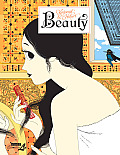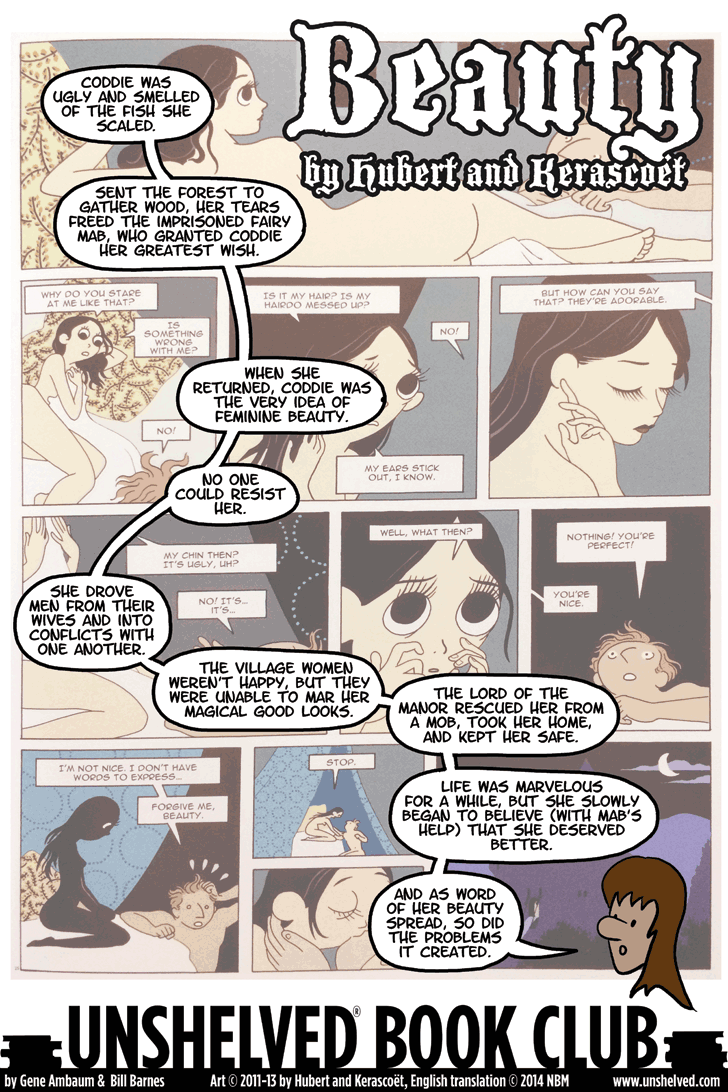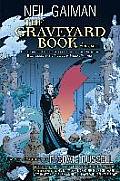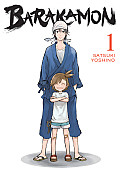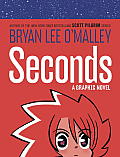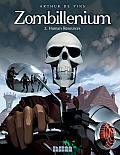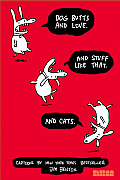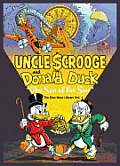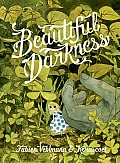Link to this review in the form of a comic strip by geneambaum tagged graphic novel • fantasy
Link to this review by snow tagged graphic novel • horror • coming of age
Nobody Owens — known as Bod — lives in a graveyard surrounded by the dead. He’s being raised and educated by the ghosts and looked after by Silas, who is neither living nor dead. He has plenty of adventures, from exploring the graves with a human girl to the tradition of the Macabray, a strange interaction between ghosts and humans. But Bod is also trapped in the graveyard, unable to leave for fear that Jack — the man who slaughtered his family — will find him and finish the job.
Why I picked it up: Despite being a fan of Gaiman’s writing, I have, for no good reason, never finished the Newbery Award-winning The Graveyard Book. In general I’m leery of graphic novel adaptations, but I love Russell’s art, so I decided to give this a try.
Why I finished it: When I first picked it up at the library, I was surprised and a little disappointed to find out that the illustrations were not all done by Russell, though he does do the cover and one of the chapters. But once I started reading, I discovered that all of the artists adapted their own styles to blend with Russell’s trademark, ethereal style enough to make the graphic novel cohesive. Tony Harris’s and Scott Hampton’s drawings are the most different from Russell’s — Harris uses thicker, darker lines and Hampton’s are softer and less solid — but even those variations work in the story they illustrated together, in which Bod gets a new teacher and takes an unwilling trip to the ghoul underworld.
Each chapter reads like a short story, so having different artists draw each was not as jarring as it might otherwise have been, especially since the book had only one colorist (Lovern Kindzierski). And the short story-feel left me wanting to read book two without resorting to a frustrating cliffhanger.
It’s perfect for: Rosie, who at age ten has begun to think that her parents might not be as awesome as she previously believed, especially since she’s in her mother’s fifth-grade class this year. She’ll understand Bod’s frustration with teachers who want him to learn seemingly meaningless things. (In Rosie’s case that means science, while in Bod’s it is how to properly call for help in obscure languages not spoken by any human.)
Link to this review by snow tagged graphic novel • art • coming of age
Seishuu is an award-winning young calligrapher, but after punching the director of an exhibit hall who calls his calligraphy dull and conformist, he leaves Tokyo and moves to an island off the western coast of Japan. There he plans to work on his art, but he is constantly interrupted by Naru, a young girl who keeps showing up in his house. Chasing Naru out leads to following her around the island on a series of adventures and that may be just what Seishuu needs.
Why I picked it up: The characters on the cover looked like they could be from any historical or fantasy manga, but the description made it sound like the type of slice-of-life manga that I enjoy. I was intrigued by the contrast.
Why I finished it: I loved the focus on Seishuu’s struggles to find his own voice in his art. I am only a new quilter, but I find myself wanting to do the same, to leave a personal mark on what I make and to sew quilts that are fresh, alive, and vibrant. Yoshino focuses on the joy of creating art in a segment where Seishuu, invigorated by an adventure with Naru, flings ink freely onto a canvas with first a brush and then all ten fingers.
Readalikes: A top-notch slice-of-modern-Japanese-life manga is the adorable, all-ages series Yotsuba&! by Kiyohiko Azuma. Yotsuba is an energetic, little, green-haired girl who lives with her father and gets into all sorts of mischief. Both series are full of humor and nostalgia for the magic and freedom of childhood.
Link to this review by dawnrutherford tagged coming of age • fantasy • graphic novel
Pushing thirty, Katie is head chef in a successful restaurant, Seconds, which she started with a group of friends. Most of them have moved on to other ventures, and Katie feels it’s time she has a place of her own. She has saved money by living in the small room above Seconds, and is now investing it in a new restaurant. Her first step is renovating a building in a bad part of town.
One night, at home, she discovers a tiny notebook and a mushroom in a drawer that she could have sworn was empty. The instructions in the notebook tell her that if she writes down a mistake, then eats the mushroom and goes to sleep, she will get a second chance. So she writes, ”I shouldn’t have fooled around w/ ANDREW! Workplace canoodling is NO GOOD!” When she wakes up, she finds that the kitchen accident she caused the previous day never happened. And she wonders what else she can she fix.
Why I picked it up: O’Malley’s Scott Pilgrim series was an enjoyable mix of manga-style drawings, contemporary pop-culture references, and emotionally charged characters. I’ve been waiting for years to see what he would come up with next.
Why I finished it: I was pleasantly surprised by the book’s mix of supernatural and foodie themes. Katie is creative and brave in the kitchen (I would love to try the Saddle of Rabbit she throws together), but she is amazingly stubborn and self-centered, too. It takes a rough relationship with her house-spirit to get her to realize she not only has regrets, but that only she can make good on them.
Readalikes: While it doesn’t have any wide-eyed fashionistas like Seconds, the Oishinbo: à la Carte series by Tetsu Kariya and Akira Hanasaki is a must-read for manga-loving foodies. Each of the seven volumes published in the U.S. explores a different type of food like pub grub, fish, and sake. And even better, to supplement all the yummy stuff in the stories, each volume includes a recipe with color photographs and step-by-step instructions.
Link to this review by sarahhunt tagged comic strips
An introduction to the comic strip Mutts. Each chapter features one of the characters from the series.
Why I picked it up: This is part of a series of comics from Andrews McMeel that has huge kid appeal. It’s the size of a regular paperback book so it doesn’t look like a comic collection, and inside are full-color comics, the strips carefully selected to be a great kid-level introductions to the series. (I can’t wait to show it to grade schoolers!)
Why I finished it: McDonnell’s characters are tremendously earnest and sweet, and even a sweary crab and cranky neighbor cat have their own charm. I can totally see the jokes being repeated to me through gales of laughter by little kids.
It’s perfect for: Kelly, who would rather bury her nose in a book than make new friends at her school. I think she could pick up some good friendship tips from Earl, Mooch, and the guard dog who just wants some love.
Link to this review by wally tagged humor • graphic novel • horror
Zombillenium is one scary amusement park, or at least it tries to be. Most of the human visitors are not afraid of the Michael Jackson zombie doing his “Thriller” number, and the ghost dancers are literally booed offstage.
Aurelian Zahner, an unemployed young man whose wife is fooling around on him, goes into a café with a gun, meaning to rob it. Gretchen, a young witch, turns the gun into a banana. Embarrassed by his failure, Aurelian runs out into the street where he is hit and killed by Francis Von Bloodt, the suave old vampire who runs Zombillenium and is driving a couple of his undead employees back to work. Van Bloodt revives Aurelian with a bite. Aurelian’s future as the demonic mascot of the amusement park is assured when Andrew the werewolf also bites him.
Why I picked it up: Arthur de Pins has a crisp, clean style of drawing that I like, and these books looked like they would provide as much humor as horror.
Why I finished it: The plots are outlandish, of course, and play on many familiar horror tropes, but there was a lot of bloody, good fun in the telling. In an early scene, Von Bloodt and Andrew the werewolf both want to make Aurelian into their type of monster, so they keep biting him until there is quite a bit of dripping and crunching. In my favorite flashback scene, Gretchen the witch (and the only human employee of the park) recalls her schooldays at a certain magical college where everyone seemed overly interested in the size of their magic wands. She is shown sitting nude on a rumpled bed talking to a sad, dark-haired boy, “Harry, it’s OK. Those things happen.”
Readalikes: Richard Moore’s Boneyard series, since both books involve an ordinary human encountering a funny undead community.
Link to this review by geneambaum tagged comic strips • humor
Crass one-panel and one-page comics from Jim Benton, creator of It’s Happy Bunny and Dear Dumb Diary. An attack dog uses email, another serves “dead shit” out of a food cart, the Easter Bunny cuts eyelids off kids, a dragon makes out with a knight, and Luke plays with a lightsaber.
There’s more, too. But here’s the comic that will get you to give this book a try.
Why I picked it up: Best title I’ve seen all year.
Why I finished it: Benton seems to be able to draw anything in any style, from colorful, anthropomorphized lighters to a goth Poe with a raven to cartoony Batman and Avengers parodies. His use of color is particularly impressive. You can see what I mean by checking out the comics here.
It’s perfect for: My daughter, who never cleans up her room. I’ve left it laying around with a bookmark in the “Great Moments in Laziness” page. (The cartoon’s ending is brilliant, a half-drawn panel.)
Link to this review by wally tagged graphic novel • humor
Thirteen stories featuring Disney’s most famous ducks. In the title story, Uncle Scrooge is giving his nephew Donald and the young Huey, Dewey, and Louie a tour of his museum, which displays the spoils of his many adventures. There they meet Flintheart Glomgold, another bazillionaire. He and Uncle Scrooge argue about who is the richest duck in the world, and when things get violent, a vase breaks, revealing an Incan treasure map. The race is on to get to the gold.
Why I picked it up: When I was a kid, our family road trips were quicker because my parents bought me lost of comics to read in the car. Scrooge McDuck stories were my favorites. They took me around the globe, always put a premium on breathless plot twists and derring-do, and they had lots of visual puns.
Why I finished it: I had fun seeing Scrooge, Donald, and the boys make their way through a secret mountain in search of lost gold. Even though they lose it in the end, Scrooge finds a way to stake a claim to the bottomless lake into which the treasure vanishes. Other stories in the book feature old favorites like Gyro Gearloose, the inventor of impossible machines, Daisy Duck, and Gladstone Gander, the luckiest duck in the world.
It’s perfect for: Scott. Even though his favorite wealthy comic character was Richie Rich, he would love Scrooge’s constant scheming to make more money and keep it. In one story, “Cash Flow,” Scrooge faces off against the Beagle Boys, who get their hands on two ray guns, one that causes everything to be super-slippery and another that negates inertia. The Boys look like they have Scrooge’s massive money bin all to themselves, but the ducks turn the rays against them and save the day.
Link to this review by geneambaum tagged graphic novel
Aurora is having cake and hot chocolate with Prince Hector when the ceiling starts to drip. Aurora flees and is nearly trapped in a dead end, but she pushes through and emerges into the rain, in the forest, from the orifices of a dead girl’s head, along with many other tiny people. The next day they seem unperturbed (or unaware) of the dead “giant” (she’s our size) and set about gathering food and trying to figure out how to live. (Recycling the contents of the dead girl’s backpack is a big part of this.) Aurora strives to be helpful and to make sure everyone has a fair share of what’s available, but life in the forest is dangerous, and many of the tiny people are far less noble than Aurora.
Why I picked it up: The happy looking miniature girl on the cover made me wonder about the title. Then I noticed she was peering from behind a giant, grey hand. Together with the back cover’s fly-covered, discolored legs, that hinted at something horrific.
Why I finished it: This looks like an upbeat, beautiful graphic novel about tiny people along the lines of Miyazaki’s The Secret World of Arrietty, but it quickly becomes clear that it’s much darker. When a little blue girl climbs into a bird’s nest to be fed with the other chicks, the mama bird plunges a bug deeply into her open mouth, turning her face into a bloody mess. A helpless, swaddled baby is repeatedly forgotten and abandoned. Throughout it all, the dead girl’s body rots in the forest, forgotten by everyone except the little person who lives in the hole in her skull.
It’s perfect for: My friend Darcy’s eight-year-old daughter, who chose a volume of Roman Dirge’s Lenore on a recent trip to the bookstore with her grandma. Apparently she’s a fan of dead girls, cannibals, and monsters, so who am I to argue?
